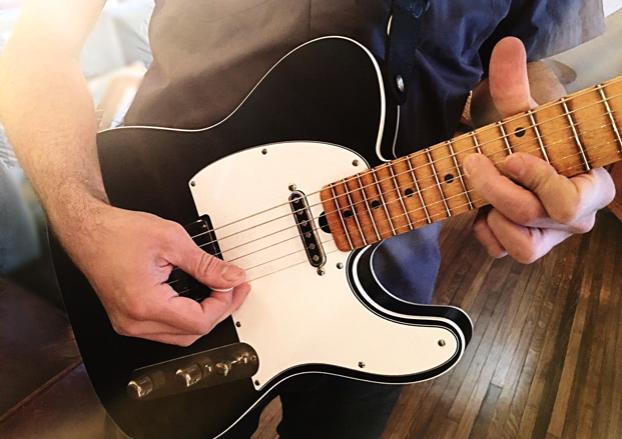The Art of Phrasing: Four Simple Ways to Make Your Leads Sing
Some methods to make your lead playing more melodic and dynamic.

When one of my guitar students wants to learn lead guitar, I usually show him/her the minor pentatonic scale first.
Once that scale is down in all keys, I play different and familiar chord progressions and have my students solo over them using the scales they've just learned.
Almost always, the same thing happens: The student's leads sound like a continuous scale.
I call it the musical equivalent of a stomach virus: The notes just keep on running out with no end in sight. The same thing occurs when they advance and learn the extensions of the minor pentatonic and the modes. They know the notes and the connections very well, but it sounds like one big run-on sentence. Sometimes I'll see cover bands in which more experienced guitarists will do the same. In short, there is no phrasing.
Here are some methods I've used to make lead playing more melodic and dynamic.
01. LISTEN BEFORE YOU PLAY: Sometimes I'll start a profession and the student will just jump in and start playing licks. I always stress to them to listen for a few bars to what the chords sound like, especially if you are unfamiliar with the structure. By listening first, you may be able to hear something you wouldn't have heard before, such as a rhythmic or melodic motive you can build a lead line from.
02. REST, SILENCE AND RHYTHM: Let the notes breathe a little bit. Slow down the phrase and maybe stop playing all together. The silence in music is just as important and the music itself. The silence can draw in the listener. Holding a note a little longer can do the same. The use of silence and resting will make the scale sound less like a scale, if you catch my drift.
Here's a great example: Play a descending D major scale. Pretty boring stuff. Now alter the spacing a bit and change up some of the rhythms, hold certain notes longer and shorter ... the next thing you know, you're playing one of the most recognizable melodies of all time, "Joy to the World." That's what we are shooting for in lead playing—making something ordinary into something special. And that's what separates the good from the great.
03. ACCENTUATE CERTAIN NOTES: Above, I referred to run-on sentences. Is there anything more annoying than hearing a speech in which the speaker has no articulation, speaks without pauses and is monotone? Probably not. The same can be said about lead guitar playing.
Think of the phrase "I love you." Three short powerful words. But if I accentuate and put emphasis on different words, the meaning drastically changes. "I love you." "I love you." "I love you." If you say those words out loud accentuating the different words, you'll hear the difference. The meaning of the phrase changes. Do the same in your lead playing. You can stress a few of the notes in a phrase by making them louder or softer, longer of shorter. If you do so, the whole context and meaning of the phrase will change into something unique. You can play one phrase faster; then in the next phrase, play something slower and softer holding a few of the notes. The ideas are limitless.
04. LISTEN TO OTHER LEAD GUITAR PLAYERS: This seems like a no-brainer, but you'd be surprised how many young guitar players who want to play lead have never heard of David Gilmour. You need to listen to music in which the art of lead guitar is prevalent. It is so important to immerse yourself in the music of other lead guitarists who have come before us and who are here now! You get the creative juices flowing and draw inspiration from them. The examples are too numerous to mention, but a few examples are Jimi Hendrix, Jimmy Page, Eric Clapton, Eric Johnson, Slash, Eddie Van Halen, Billy Gibbons, Joe Bonamassa, etc., etc., etc.
Guitarist Richard Rossicone is a veteran of the New York City and Long Island original and cover band scene. He's been playing since he was 8, when he attended his first concert (Kiss) and saw Pete Townshend smash a guitar. He has studied with various instructors over the years, which led him to a career in music therapy. He began his educational journey at Queensboro Community College, where the faculty introducing him to classical music. He received his associate's degree in fine arts in 1997 and went on to receive his bachelor's in music therapy in 2001 and his master's in music therapy from New York University in 2004. He's been Board Certified as a music therapist since 2002. Richard continued his studies at C.W. Post University, pursuing a second master's degree in classical guitar performance and music history, studying under Harris Becker. He's been teaching guitar, piano and theory since 2002 and in 2006 started his own company, Rossicone Music Studios. Richard is the co-lead guitarist in Bad Habits, NYC's premier Thin Lizzy tribute band. Visit him at Axgrinder.com
Get The Pick Newsletter
All the latest guitar news, interviews, lessons, reviews, deals and more, direct to your inbox!









![Joe Bonamassa [left] wears a deep blue suit and polka-dotted shirt and plays his green refin Strat; the late Irish blues legend Rory Gallagher [right] screams and inflicts some punishment on his heavily worn number one Stratocaster.](https://cdn.mos.cms.futurecdn.net/cw28h7UBcTVfTLs7p7eiLe.jpg)
